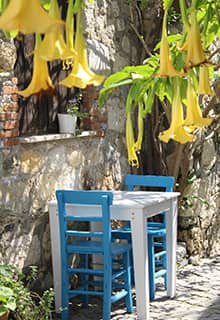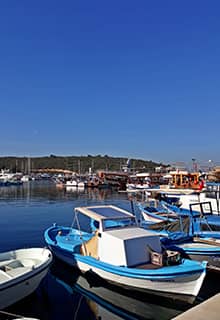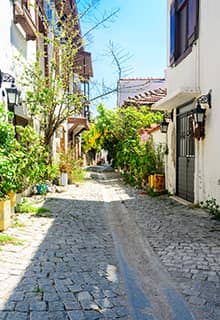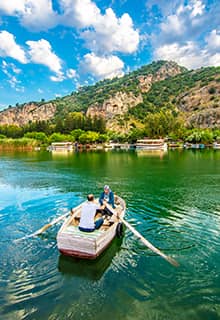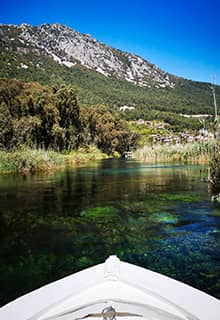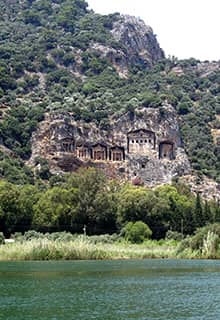

cittaslow cities Aegean
Türkiye
İZMİR/AKYAKA/KÖYCEĞİZ/SEFERİHİSAR/YENİPAZAR/GÖKÇEADA/FOÇA
İzmir
Continuously inhabited for more than 8,500 years, İzmir is considered one of the world’s oldest cities and one of the loveliest. Known as “Beautiful İzmir” throughout Türkiye, İzmir joined the Cittaslow Slow City network as its first Cittaslow Metropol pilot city. The Cittaslow Metropol Project was formed to define a model for the Cittaslow philosophy in metropolitan cities and, according to Cittaslow, İzmir has been “presenting the best examples of living together for hundreds of years.”
In describing İzmir, the historian Herodotus wrote, “They built their city under the loftiest dome of heaven and the best climate in the world.” Aristotle said to his pupil, Alexander the Great, “You are not complete unless you have seen it,” and Victor Hugo expressed that “Smyrna is a princess...”.
These accolades are well deserved. The last point on the ancient “King’s Road” stretching from Anatolia to the Persian Gulf, İzmir is built around an expansive bay dotted with yachts, ships and ferries. The city’s streets are shaded by palm trees and lined with elegant structures.
İzmir is the sound of the sea and the wind. Thanks to its Mediterranean climate, İzmir is mostly sunny all year round. Summers are hot and winters are mild. The 629-kilometre-long coastline of İzmir offers restaurants and cafes that serve fresh seafood and Aegean specialties, as well as entertainment facilities, magnificent sea views and 49 beautiful Blue Flag beaches. Highlights include seaside walks in Kordon, and ferry rides from Alsancak to Karşıyaka.
Inland, the stories of countless civilizations are vividly told through ancient ruins and monuments.
Districts and historical sites such as Bergama, Çeşme, Foça, Kemalpaşa, Selçuk, Seferihisar, Karaburun, Tire and Urla testify to the important role İzmir has played in history, not only in Western Türkiye but across the entire Aegean region.
İzmir has important ancient cities, two of which are on the UNESCO World Heritage Site List. Considered among the most important of these is the ancient city of Ephesus, in Selçuk. The sixth-century BC Artemision, the largest temple dedicated to Artemis, was built at the foot of Ayasuluk Hill in front of the city’s oldest port, a site considered sacred in antiquity and based on the ancient mother goddess tradition of Anatolia. The temple itself is considered one of the Seven Wonders of the ancient world. As Ephesus has undergone rebuilding throughout its history, its ruins extend over a wide area.
Ephesus and its surroundings are included in the World Heritage List as four components: the Çukuriçi Mound, Ayasuluk Hill (Selçuk Castle, St. John’s Basilica, İsa Bey Bath, İsa Bey Mosque, Artemision), Ephesus Ancient City, and the House of the Virgin Mary. Ephesus, an area of uninterrupted settlement area for approximately nine thousand years stretching from the prehistoric period to the Hellenistic, Roman, Eastern Roman, Turkish Principalities and Ottoman periods, has been a prominent port city as well as a cultural and commercial centre at every stage of history.
Another ancient city is Bergama. Formerly known as Pergamum, it was the first UNESCO World Heritage Site in İzmir and the thirteenth in Türkiye. Bergama was principal cultural center in ancient times and served as the capital of the Kingdom of Pergamum. Numerous well-preserved buildings and sites from the past have survived to the present day, including the Pergamene Acropolis, the Temple of Asclepius, and the Red Basilica (known as the “Kızıl Avlu /Red Courtyard” in Turkish). The Pergamon Museum exhibits many of the finds obtained from excavations around Pergamon.
Türkiye’s longest-standing open market area, Bergama Arasta (Ottoman Bazaar), is also noteworthy.
Located between the İzmir city centre and the renowned holiday resort of Çeşme, Urla offers an authentic and multicultural setting featuring picturesque cobblestone streets, pocket-sized squares, and cafes shaded by centuries-old plane trees. Fishing boats, village markets, vineyards, wineries and olive groves further convey the Aegean spirit of Urla.
In Anatolia, olives have been known for about six thousand years. The world’s oldest olive oil workshop was discovered at the ancient Klazomenai in Urla. The microclimate and terrain of Klazomenai are also ideally suited for viticulture; wines produced in ancient times were found in unique amphorae. Archeological finds indicate that these wines were sold across a wide geography covering the Western Mediterranean and Black Sea coasts from the seventh century BC.
The Urla Vineyard Route (Urla Bağ Rotası) presents visitors with an opportunity to sample high-quality wines made from grapes with a six-thousand-year history. In addition, visitors can enjoy peaceful vineyard walks, first-class wineries in boutique establishments, and dining in outstanding gourmet restaurants.
The Urla Vineyard Route is a haven of serene landscapes featuring traditional stone cottages, wine houses meeting with elegance, palm trees and horse ranches. In the harvest season, vineyards are colourful with brilliant green vines and fat, juicy red grapes.
In addition to wines, Türkiye’s Aegean region is famous for its cuisine, which spotlights herb dishes, artichoke dishes, and appetizers made using olive oil (hot or cold small plates served before or during meals). This distinctive and very local cuisine is beautifully complemented by the regional wines – Afiyet olsun!
Akyaka
Imagine a quiet town located between the lush mountains and the turquoise sea. Everything you eat is grown in the natural, unpolluted environment of the surrounding region. There is no noise pollution.
Located just north of Marmaris in Muğla Province, at the far end of the Gulf of Gökova, Akyaka is a lovely small town surrounded by pine trees. As a result of its geographical location, there are many opportunities here to participate in outdoor sports such as windsurfing, sea kayaking, biking, kitesurfing, rock climbing, sailing, paragliding, rafting, trekking, and riding.
Lying in the valley of the Azmak River, Akyaka is surrounded by fragrant eucalyptus trees. The river flows down through fields to the seafront, where you will find a small sandy beach and several beachfront restaurants.
Akyaka’s past dates to antiquity. A Carian city named “Idyma” was established in ancient times in this district that was known as “Rhodian Peraea,” denoting the mainland territorial possessions of the island of Rhodes. The stone burial sites at the passageway to Akyaka date to that period. Akyaka was a little fishing town until the 1970s, when it was discovered by artists looking to escape urban life.
Sedir Adası (Cedar Island) in the Gulf of Gokova is full of ancient ruins. In the distant past, the island used to be called “Cedrae” from “Cedrus,” a cedar tree. According to certain sources, the Caryan royal family spent their summers here.
The stream Kadın Azmağı flows through Akyaka to the Gulf of Gokova, moving between trees and reeds, at times displaying a magnificent turquoise color. You can take a boat ride on the steam and enjoy a cup of tea watching the water gently move downstream.
Köyceğiz
At the easternmost part of the Mediterranean, the southernmost part of the Aegean Sea, at the junction of the Carian and Lycian civilizations, there is a region where blue and green dance together and where history is as ancient as time itself. Köyceğiz is a true heaven on earth, located east of Marmaris.
Köyceğiz is a town and district located on the north shores of Lake Köyceğiz. In ancient times, the lake was a bay situated on the Mediterranean coast. However, the alluvia that was carried by the Dalaman River in time narrowed the strip of land between the sea and the bay and created a lake. Today, the only link between the sea and the lake is the Dalyan River, where boat and canoe tours are offered.
Köyceğiz hosts the ruins of the ancient city of Kaunos. Kaunos is known to be the oldest settlement in the region. Archaeological excavations have revealed that settlement here began in the 8th century BC. The site was inhabited by Romans, Persians, Rhodians. Among the ancient ruins, there is an ancient theater and rock tombs.
You can take an incredible boat trip on Lake Köyceğiz accompanied by the perfume of orange blossoms and sweetgum trees, and views of Mountain Sandras. You might also be greeted by loggerhead sea turtles, or Caretta carettas, that take refuge in the Köyceğiz-Dalyan Special Environmental Protection Area.
The people of Köyceğiz take pride in their local traditions, offering visitors ample opportunities to taste their local cuisine. The area is famous for its paths in the lake's recreation areas, and for the lack of traffic lights in the town center. It is also worth mentioning that no heating coal is allowed in winter to prevent air pollution.
Seferihisar
Situated in the south of İzmir city, Seferihisar is the meeting point of nature, history, and the sea. It is the first town in Türkiye to join the Cittaslow movement.
In Seferihisar, the streetlamps are solar powered. Local seeds are grown, and mesh net bags are used instead of nylon bags where local goods are sold. The district's restaurants offer the local delicacies that are unique to Seferihisar. Homemade, fresh, and natural products can be found in the market that is set up inside the Sığacık Castle every Sunday.
The archaeological site of Teos, located 5 kilometers from Seferihisar, is one of the oldest and most important historical ruins in the district. Teos was one of the 12 Ionian cities of the Ionian League, and according to the historian Pausanias it was established by the descendants of Athamas, a mythological Boeotian king.
Seferihisar has a 49-kilometer-long coastline with many beaches and bays, each more beautiful than the next. The district has the most beaches with Blue Flag in Türkiye. There are 11 in total, 9 of which are public beaches. Daily charter boats that tour the district’s beautiful bays leave from Sığacık Port.
Seferihisar is the tangerine capital of Türkiye, and each year in November, it welcomes the tangerine season with the Tangerine Festival. Many mouthwatering delicacies made of tangerines are available to taste at the festival.
Apart from citrus fruits, Seferihisar is also famous for its winegrowing.
Yenipazar
Yenipazar is a small and quiet district located in western Türkiye, in the Aegean region. It is 40 km from Aydın city center, and 100 kilometers from Kuşadası.
In the middle of the Menderes basin, Yenipazar is built on the slopes of Madran Baba Mountain and on the northern side, it is surrounded by forests.
The ancient city of Orthosia, inhabited during the Hellenistic, Roman, and Byzantine times, is near Yenipazar.
One of the places one must visit in Yenipazar is the Aşağı Dip Lake Nature Park. The park has a viewing terrace, fishing platforms, a bird-watching tower, and hiking trails.
While enjoying the silence of nature, you can have a small picnic, fish, and observe the ducks, rails, and various other birds from the bird-watching tower.
Gökçeada
Gökçeada, located in the northwest Aegean region, is Türkiye’s largest island. It is famous for its singular geography and protected natural resources.
Gökçeada offers its guests a unique natural environment thanks to the organic agricultural activities that commenced on the island in 2002 and the rural tourism practices that started in 2008. Gökçeada has become the first and only “quiet island” in the world thanks to the title of “Cittaslow” it received in June 2011.
Visitors will be fascinated by the range of local art ranging from the island’s authentic handicrafts and regional folkloric artifacts to examples of world avant-garde art. The island warmly embraces cultural variety, and accommodates various customs and traditions, a rich food culture, and unique architecture.
Gökçeada’s marine life is equally rich. The sea surrounding the island is rich in sea bream, horse mackerel, chub mackerel, mackerel, sea bass, carp, seabream, red mullet, two-banded seabream, bream, and dusky grouper.
Gökçeada is also known by its historical name Imvoz, which is believed to derive from the mythological river god Imbrasos. The name “Imroz” is mentioned several times in Homer’s epic Iliad. According to Homer, "At the bottom of the sea in the abyss, between Tenedos and rocky Imroz, there is an immense cave. Poseidon's horses rested there, and the earth shook." During the Trojan War, the inhabitants of Imroz, allied themselves with Troy. Homer tells us that when Achilles took Priam's son prisoner, the king of Imroz bought him and sent him back to his father.
Foça
The town of Foça is located 69 kilometers northwest of İzmir, right by the Aegean Sea. With its five thousand years old history, Foça has traces of different periods. It is home to Mediterranean Monk seals as the ancient name of the city Phokaia bears. As an important port town with renowned sailors and colonists, they are known as the first to make and use coins made with a blend of gold and silver. As it was home to several ancient civilizations in the past, Foça is an important archaeological site in Türkiye.
With its sustainable way of living, rich archaeological heritage that transcends ages, and endemic flora and fauna, Foça was inscribed as a Cittaslow town in 2021. It is where some of the highest quality natural and organic produce is harvested such as olives, grapes, and figs.
The locals of Foça make sure to preserve the traditions, rituals, cultural symbols, handcrafts, and more that guaranteed its entry to the Cittaslow list.


